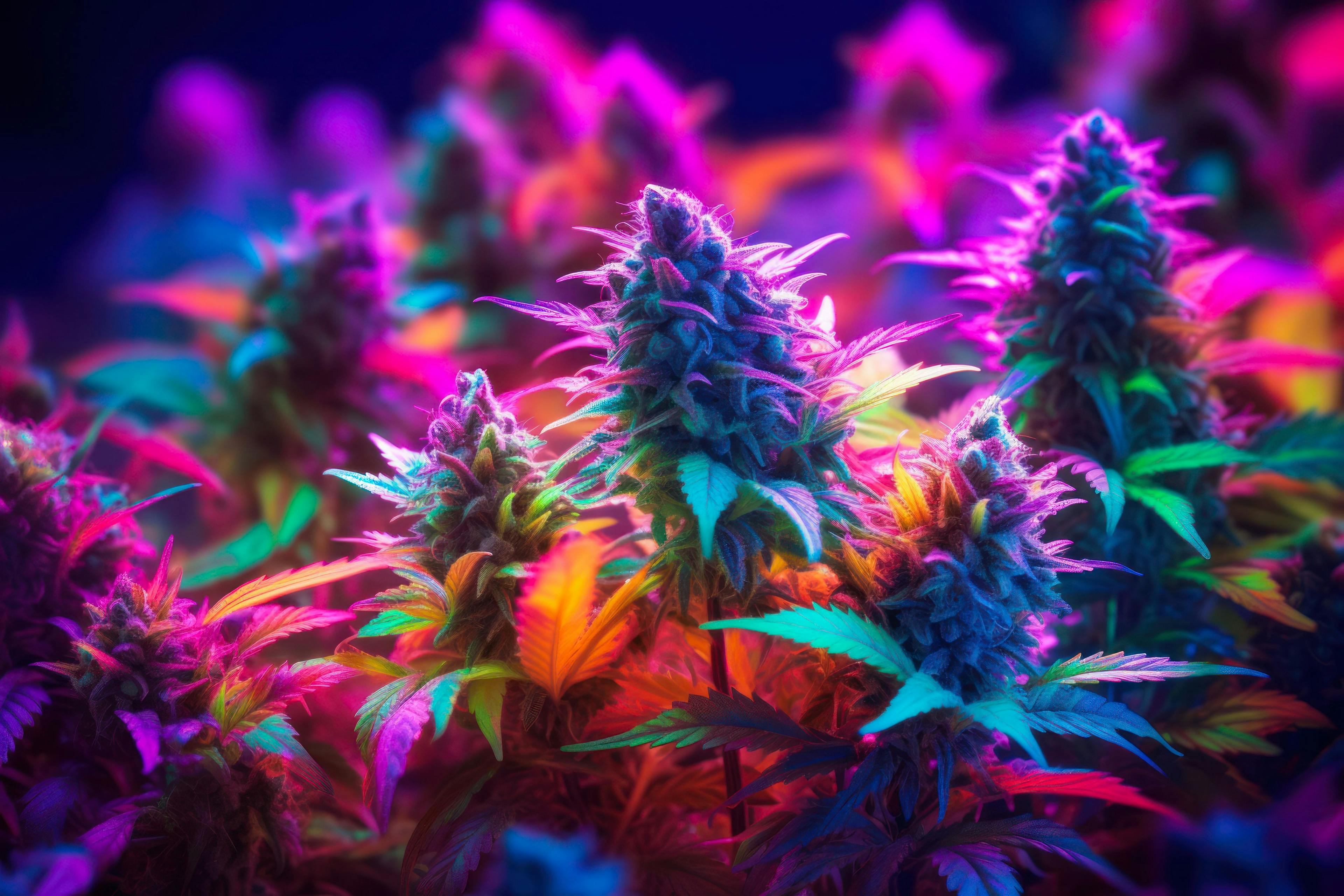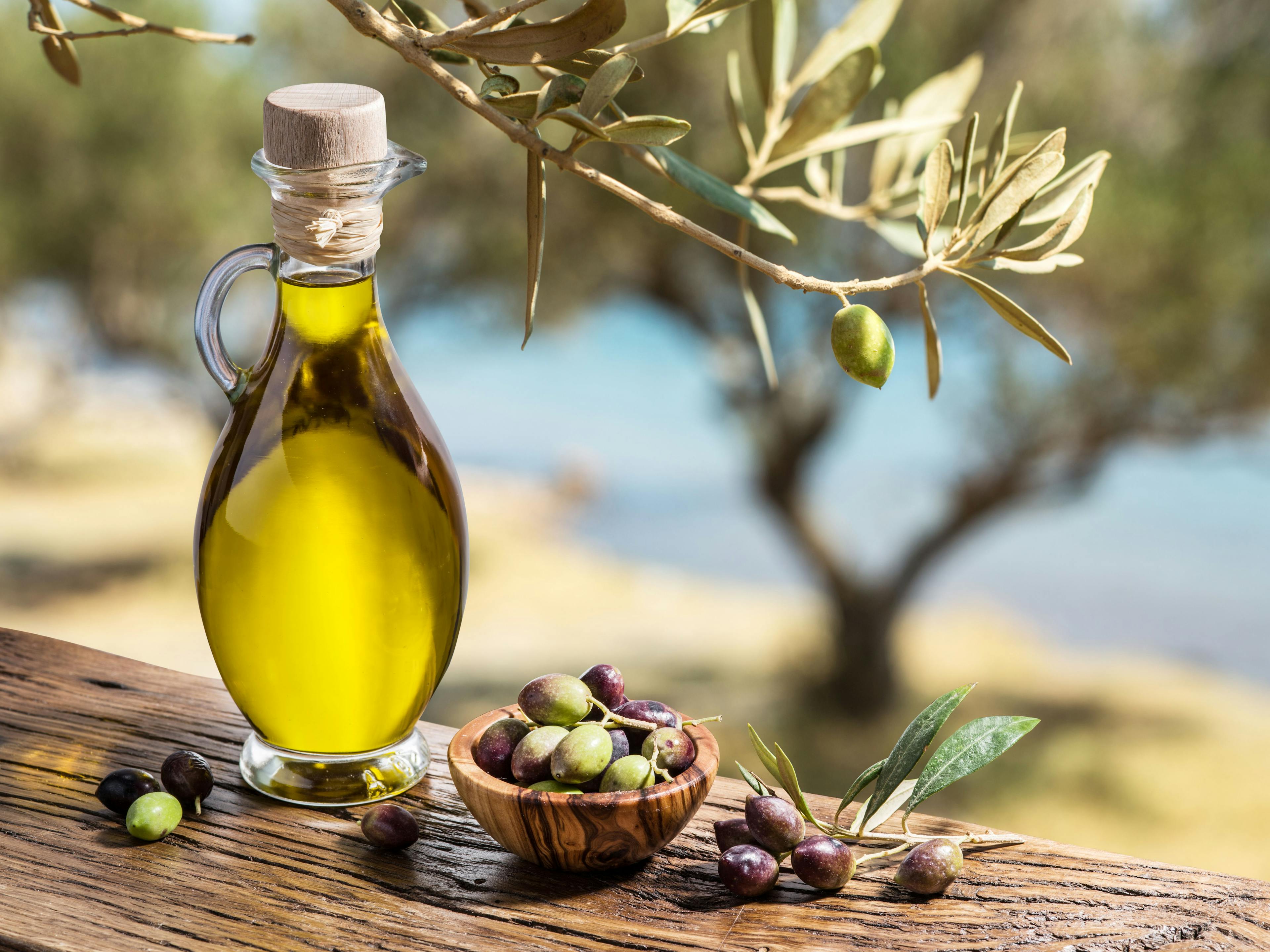From “Green” to “Sustainable” Sample Preparation in Omics Studies in the Natural Product Field: Case Studies Dealing with Cannabis sativa L.
Plant metabolomics requires that as many metabolites as possible are extracted to obtain a reliable picture of the sample under study. Therefore, sample preparation plays a crucial role. In recent years, several efforts have been made to improve the environmental friendliness of sample preparation, including in the plant sector. However, the environmental friendliness of a method cannot be evaluated without also considering its productivity and, more importantly, its analytical performance to ensure not only environmental friendliness but also the “sustainability” of sample preparation approaches.
Plants and natural products are rich sources of a variety of bioactive metabolites that can be used for several applications, such as food and health. Their analyses need to cover a wide range of topics, from metabolomics studies to quality and safety controls. In particular, metabolomics studies for medicinal plants are growing rapidly and aim, for example, to identify new bioactive compounds, determine balsam time, monitor plant quality, and correlate the chemical composition of a natural product with its quality. Despite the remarkable technological advances made in recent years, the chemical diversity of primary and secondary metabolites of complex natural products still poses challenges for analysis. They affect all analytical steps from sample collection and sample preparation to analysis and data processing (1).
The main challenges in the analysis of natural products are related to the complexity of the plant metabolome, which, in addition to the abundant primary metabolites, is characterized by the presence of hundreds of specialized (secondary) metabolites belonging to different chemical classes, which are often present in very different amounts and, in some cases, are susceptible to degradation. Some of these compounds (such as chlorophylls and other pigments in photosynthetic tissues) could also interfere with extraction or analysis of target compounds. It is also important to remember that the samples are mainly solids and that plant cells are protected by thick and robust lignocellulosic walls that should be disrupted if efficient extraction of intracellular metabolites is to be achieved. All these factors have led to the analysis of natural products being quite conservative, especially in terms of sample preparation, which still mainly uses traditional extraction techniques, such as liquid-liquid extraction (LLE) and Soxhlet extraction, and involves high consumption of toxic and volatile organic solvents.
The use of microextraction techniques and new classes of more sustainable extraction phases are gaining importance as they meet the criteria of green analytical chemistry (GAC) (2), particularly green sample preparation (GSP) (3,4), and are thusly applied in the plant field (5). In this sense, several metric tools have been developed in recent years to assess the greenness of a method and its compliance with GAC principles. Of fundamental importance was the development of the AGREEprep metric tool, which focuses on sample preparation and is based on the ten principles of GSP (6). At the same time, the need has arisen in recent years to conduct a holistic and comprehensive evaluation of an analytical methodology and to balance the environmental friendliness of a method with its analytical performance and practical efficiency (7,8). A global assessment of analytical methods would be beneficial to industry and quality control laboratories because, in addition to increasing interest in improving the environmental impact of analyses, industry and official laboratories are dealing with a multiplication of norms and quality standards that require accurate and reliable measurements, as well as practical considerations such as productivity, cost, and simplicity of methods. In addition, assessing the environmental impact of a method (which provides an ecological outcome) along with assessing its analytical performance (which ensures the quality of the results and thus the social impact) and its productivity (which measures the economic impact) would help to measure the degree of “sustainability” of a given method (8,9). Some tools have also been developed to critically and globally evaluate analytical methods by balancing considerations of a method’s environmental friendliness with its analytical efficiency and practical efficiency (7,10), but their application is rather scarce, particularly in the assessment of sample preparation methods. However, in plant-based metabolomics studies, reliable sample preparation is essential because, as Mushtaq and coauthors noted, “the value of the information obtained from a metabolomic study depends on how much of the metabolome is present in analyzed samples. Thus, only a comprehensive and reproducible extraction method will provide reliable data, because the metabolites that will be measured are those that were extracted and all conclusions will be built around this information” (11).
Two case studies dealing with Cannabis sativa L. will be presented here to demonstrate the importance of evaluating the overall performance of sample preparation methods, especially in the plant field.
Cannabis sativa L. is a fascinating plant that has been used for recreational, medicinal, textile, and food purposes since ancient times. From a chemical point of view, it is a very complex matrix, as it contains several classes of specialized metabolites, including more than 100 cannabinoids, 120 terpenoids (monoterpenes, sesquiterpenoids, and triterpenoids) and several flavonoids among the more than 500 compounds identified (12). The plant metabolome is highly variable depending on the part of the plant considered (Figure 1). Cannabinoids and terpenoids are produced and stored in the secretory cells of the glandular trichomes, which are located in the aerial parts of the cannabis plant and especially on the upper surfaces of the seedless female flowers. Therefore, they are mainly found in the inflorescences of the plant, while their content in the leaves decreases sharply, and they are almost absent in the barks of the stems and in the roots. In contrast, the content of flavonoids is highest in the leaves, while they are less present in the inflorescences and almost absent in the roots and stem barks (12).
FIGURE 1: Main classes of specialized metabolites in C. sativa aerial parts (12).
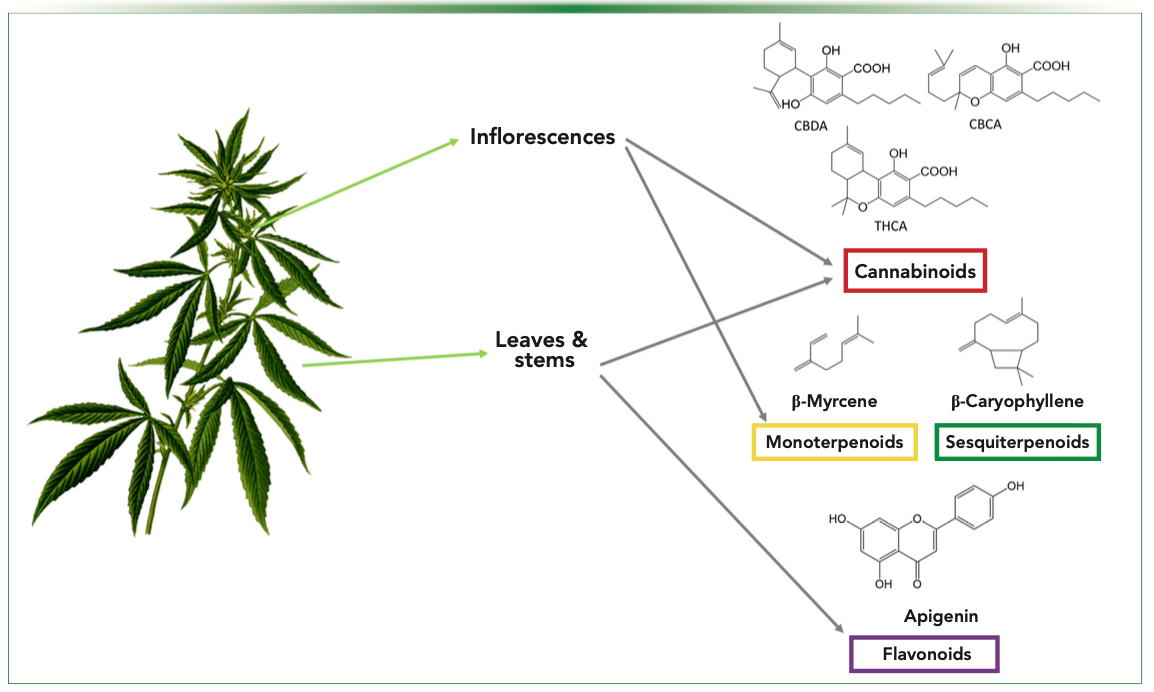
Classification and taxonomy of this plant is often difficult and ambiguous due to the high variability within the genus. Usually, a distinction is made between drug (cannabis) and fiber (hemp) types, based on the higher content of tetrahydrocannabinol (THC) and cannabidiol (CBD), respectively. Although attention has focused mainly on these two main markers, there is growing interest in exploring the bioactivity of C. sativa in terms of potential synergistic effects, the so-called entourage effect, which could contribute to or modulate the therapeutic properties of cannabis or hemp extracts. Synergistic effects have already been demonstrated in research on combinations of phytocannabinoids and phytocomplexes of cannabinoids and terpenoids. In addition, phenolic compounds are also known for their broad biological activity (13), and it is therefore important to determine the entire specialized metabolome to obtain an accurate characterization of the plant. In this sense, the extraction step is of fundamental importance, since significant differences in bioactive chemical profiles are observed in the extracts obtained with the different protocols (14).
As mentioned earlier, the inflorescences of cannabis are mainly characterized by the more volatile terpenoids and the semi-volatile cannabinoids. The most common method for extraction of cannabinoids is solid-liquid extraction (SLE) using organic solvents (such as ethanol, methanol, or acetone) coupled to high performance liquid chromatography (HPLC) or gas chromatography (GC) combined with mass spectrometry (MS). Organic solvents can also be used for the extraction of terpenoids (which are subsequently analyzed by GC), so that the two classes of compounds can be determined simultaneously by methods that can have strong environmental implications (15). Figure 2 shows the AGREEprep results for the method developed by Jin and coauthors to isolate terpenoids and cannabinoids using methanol as the extraction solvent (12). A final score of 0.27 is obtained, with several parameters showing very critical values.
FIGURE 2: AGREEprep scores of the (a) reference method (12), (b) Reg-HS-SPME, and (c) Vac-SH-SPME methods (16) that can be adopted for the determination of terpenoids and cannabinoids from C. sativa L. inflorescences.
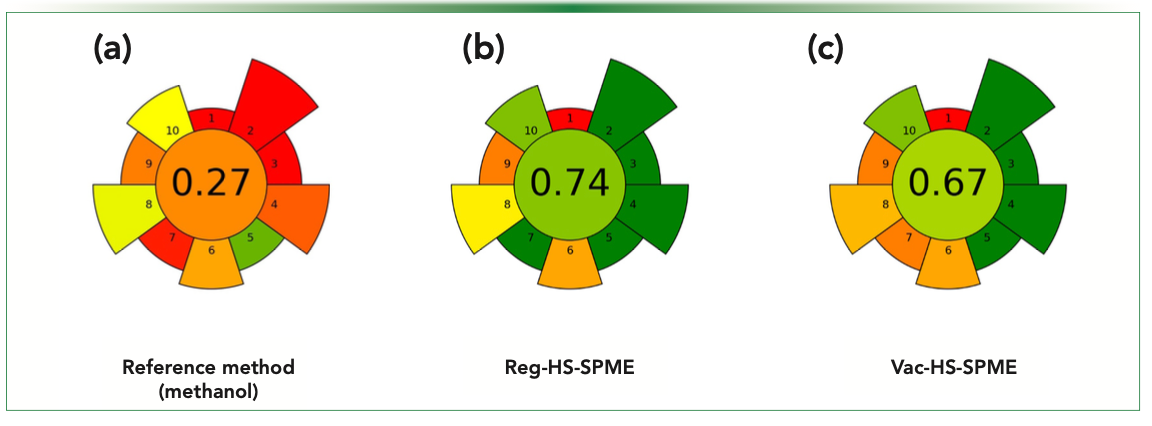
Thanks to their volatile nature, the isolation of terpenes, especially mono- and sesquiterpenes, from plant raw materials can be performed by headspace solid-phase microextraction (HS-SPME) online combined with GC–MS analysis. Recovery of the semi-volatile cannabinoids from solid matrices by HS-SPME is also possible, but requires long sampling times due to their low volatility and low tendency to escape into the headspace. Indeed, poor recovery of cannabinoids is observed when using conventional sampling conditions (90 °C and 30 min) (Figure 3a) (16).
FIGURE 3: (a) HS-SPME GC–MS profiles obtained when sampling 10 mg of matrix at 90 °C for 5 min under reduced pressure (Vac-HS-SPME) and atmospheric pressure (Reg-HS-SPME) conditions. Legend: 1) α-Pinene, 2) β-Pinene, 3) β-Myrcene, 4) Limonene, 5) Linalool, 6) Fenchol, 7) cis-Pinene hydrate, 8) Borneol, 9) α-Terpineol, 10) β-Patchoulene, 11) trans-β-Caryophyllene, 12) trans-α-Bergamotene, 13) α-Humulene, 14) trans-β-Farnesene, 15) β-Selinene, 16) α-Selinene, 17) α-Farnesene, 18-19) Sesquiterpene, 20) Selina-3,7(11)-diene, 21) trans-Nerolidol, 22) Caryophyllene oxide, 23) Guaiol, 24) 10-epi-γ-Eudesmol, 25) β-Eudesmol, 26) α-Eudesmol, 27) Bulnesol, 28) α-Bisabolol, 29) Cannabidiol, 30) Cannabichromene, 31) Cannabinoid 2 (supposed Δ9-THC). (b) Extraction temperature profiles of CBD, β-myrcene and trans-β-caryophyllene obtained under Vac- HS-SPME and Reg-HS-SPME. C) GC–MS profiles of CBD standard solution under the following conditions: injection of 1 μL of CBD standard solution 1 mg/mL; 10 μL of CBD standard solution 1 mg/mL recovered by Vac-HS-SPME after 5 min at 150 °C and 90 °C; CBD standard recovered by Reg-HS-SPME after 5 min at 150 °C and 90 °C. Legend: 1) Cannabidiol, 2) Cannabichromene, 3) Cannabinoid 1 (supposed Δ8-THC), 4) Cannabinoid 2 (supposed Δ9-THC). Modified from (16). Axis labels for Figures 3a and 3c are Time (x-axis) and Abundance (y-axis). For Figure 3b, axis labels are Analyte with respect to Temperature (x-axis) and Peak Area (y-axis).
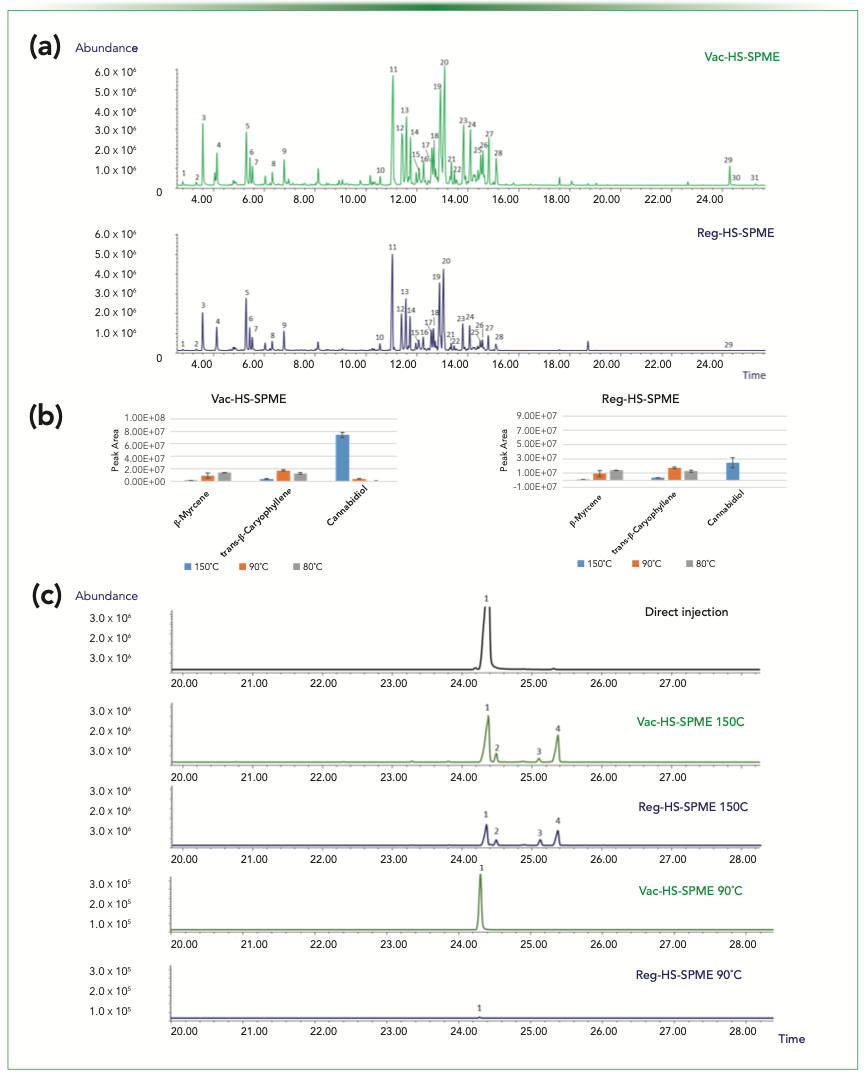
When investigating the possibility of sampling at higher temperatures, it is possible to observe that these conditions significantly discriminate against the recovery of more volatile markers (such as terpenoids) due to a reduction in the partition coefficient between the fiber and the headspace and an enhancement of competitive adsorption and displacement of low molecular weight analytes, given the extremely high amount of cannabinoids extracted (Figure 3b). Moreover, high temperature during sampling, especially when combined with relatively long extraction times, can lead to decomposition of cannabinoids and the formation of other components or artifacts (17). In fact, by submitting a CBD standard HS-SPME for only 5 min at 150 °C, it is possible to observe that the compound is degraded forming cannabinoids, including cannabichromene (CBC), Δ9-THC, and Δ8-THC (Figure 3c) (16). Thus, the HS-SPME method is certainly greener (Figure 2), but it can provide unreliable and misleading results. To maintain the optimal greenness of HS-SPME and avoid the risk of artifact formation, a very interesting option is the possibility of sampling at reduced pressure. As described in detail by Psillakis (18), vacuum is a powerful experimental parameter to consider to increase the extraction kinetic of semi-volatile compounds during the HS-SPME process. This is because, in the case of semi- volatiles and under non-equilibrium conditions, reduced pressure in the sample container decreases the resistance to mass transfer in the gas zone at the interface between the solid and the headspace. As a result, higher extraction efficiencies for semi-volatile compounds can be achieved in shorter sampling times and at milder extraction temperatures. Indeed, it can be observed that when sampling at a mild temperature (90 °C), regardless of the sampling time, the amount of CBD extracted with vacuum is several times higher than the amount obtained under regular conditions. In only 5 min, a sufficient amount of CBD could be extracted with vacuum to achieve an acceptable instrument sensitivity and to obtain a good picture of CBD abundance in inflorescences (Figures 3a and 3b). Moreover, no degradation of CBD can be observed at this temperature (Figure 3c) (16). This approach somewhat reduces the environmental friendliness of the method (Figure 2), since an additional step is introduced, but it also allows reliable results to be obtained. The three methods can be evaluated in terms of their overall performance. Among the available tools, the RGB model was chosen because it is flexible in the selection of parameters to be evaluated and the assignment of their relative weights, making it easier to adapt to the scope of the analysis and the objectives to be achieved. The name RGB is derived from the three primary colors that correspond to the three main parameters of each analytical method. The red color represents the analytical performance of the method, the green color represents its safety and greenness, and the blue color represents its productivity and practical effectiveness. An overall method score (called method brilliance) is calculated by combining the results of the three attributes, also taking into account the relative importance that the user attributes to each of them. The comparison of the RGB results is shown in Figure 4 and highlights that the analytical performance of the Vac- HS-SPME method is comparable to the conventional method, while strong improvements are obtained in terms of greenness and productivity, indicating that the method is the most reliable for metabolomics characterization of C. sativa inflorescences.
FIGURE 4: (a) RGB color model, and (b) results for the reference method and Reg-HS-SPME and Vac-SH-SPME methods developed for the determination of terpenoids and cannabinoids from C. sativa L. inflorescences.

As already mentioned, the other parts of the plant are characterized by a different phytocomplex (12). In particular, studies have shown that the aerial parts of hemp (stems and leaves) are mainly characterized by the presence of flavonoids and non-psychotomimetic cannabinoids, which can be simultaneously extracted by ultrasound-assisted methanol solid-liquid extraction (13). The method is reliable, but again, evaluation of the AGREEprep score shows that the method is quite impactful on the environment (Figure 5a).
FIGURE 5: (a) AGREEprep scores, and (b) RGB criteria and results for the reference and DES-based dispersive solid-liquid microextraction (DSLME) sample preparation methods developed for the determination of flavonoids and cannabinoids from C. sativa L. aerial parts (leaves and stems).
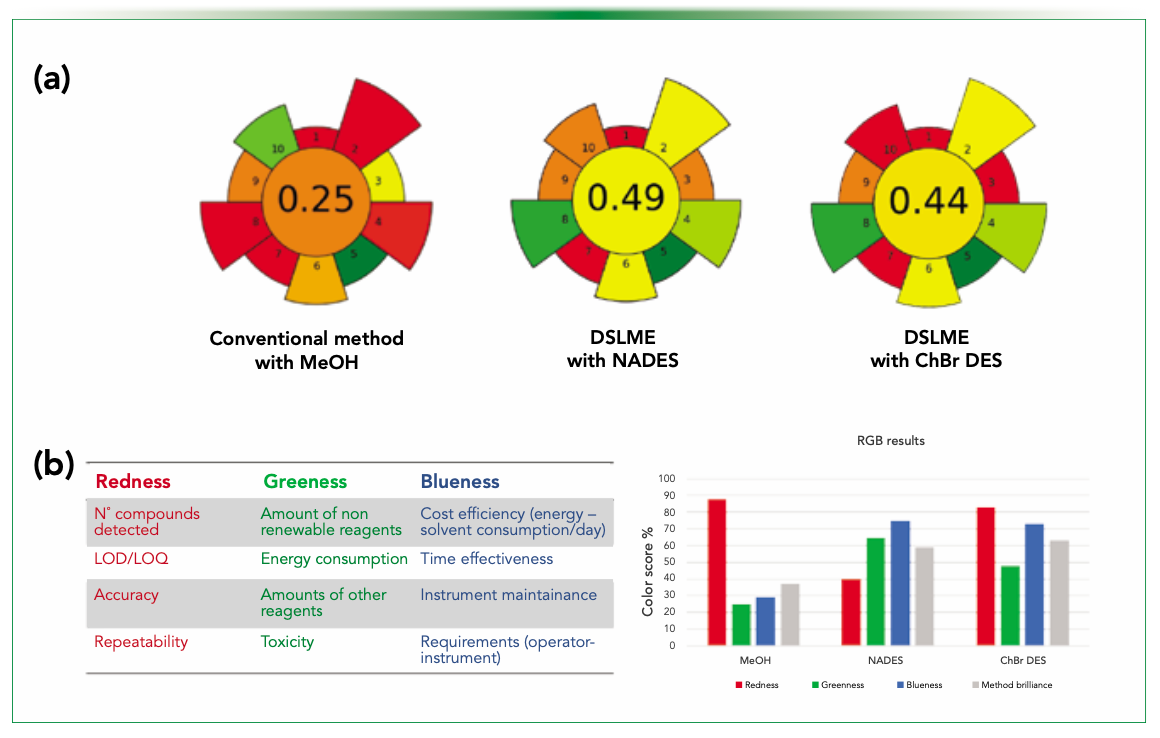
Deep eutectic solvents (DES) are a more environmentally friendly alternative to conventional solvents thanks to their ease of preparation and low raw material costs. They consist of two or more components that form a hydrogen bonding network, which is key to the formation of the DES. Various natural compounds have been used as hydrogen bond donor (HBD) or acceptor (HBA) to produce both hydrophilic and hydrophobic natural DES (NADES). Hydrophobic natural terpenoids and phenolic compounds (carvacrol, eugenol, linalool, menthol, terpinen-4-ol, and thymol) were used in a dispersive solid-liquid microextraction (DSLME) to isolate non-volatiles from hemp leaves (Figure 6) (19).
FIGURE 6: (a) Dispersive solid-liquid extraction method, and (b) extraction performance (evaluated as peak area and expressed as the mean for n = 3 replicates) of [Ch+][Br−]-based and natural DES in the analysis of the non-volatile fraction of fiber-type C. sativa L. aerial parts. Adapted from reference (20).
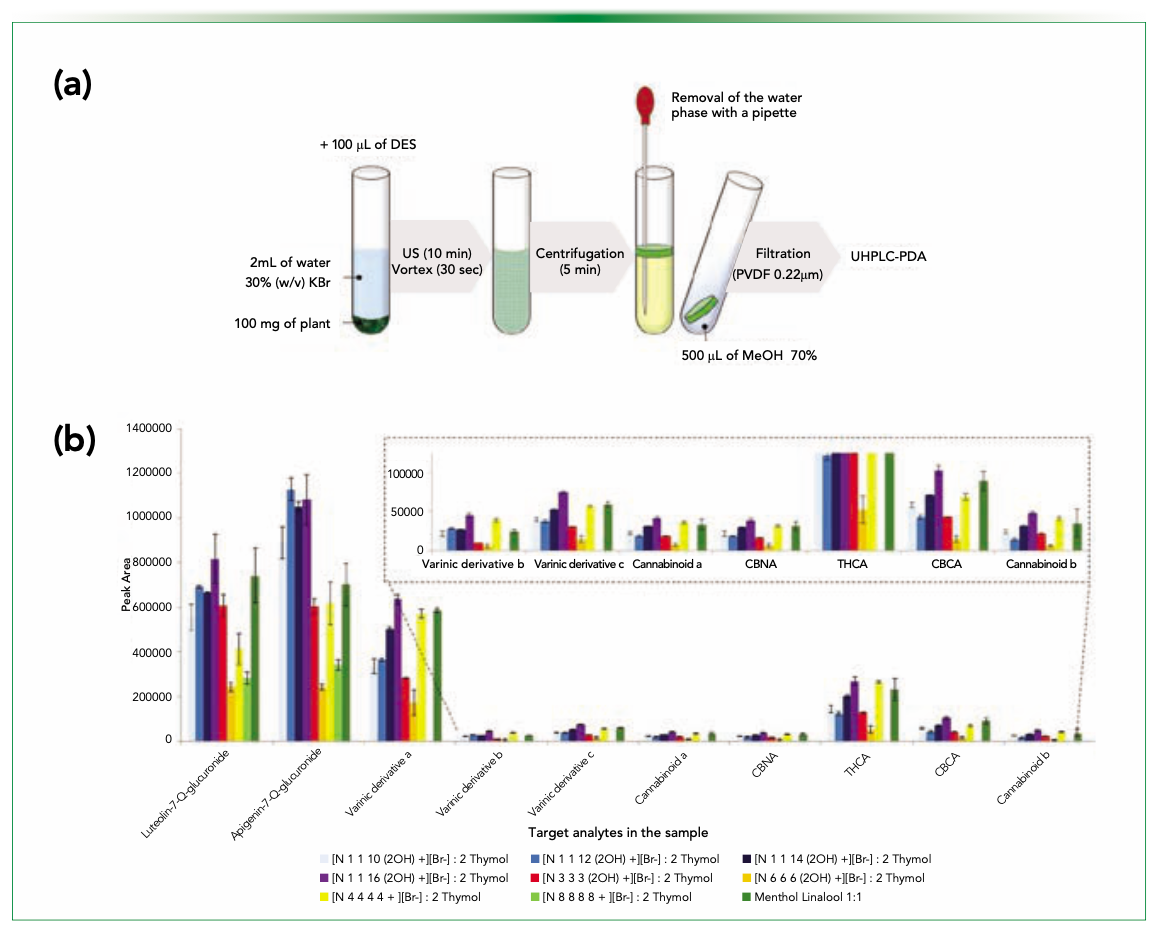
The method is certainly faster, more user-friendly, and greener than the conventional method (Figure 5a). Indeed, it only requires 100 mg of the hemp plant, 2 mL of water as cosolvent and 100 μL of eutectic solvent, which is dispersed in the sample by a vortex step, followed by 10 min of ultrasound to help release the target compounds from the plant. The NADES phase is then separated by centrifugation before analysis by HPLC. NADES are very effective in extracting the more hydrophobic cannabinoids (Figure 6b), but are less effective than the conventional method in isolating the more polar flavonoid glycosides. For this reason, a new class of hydrophobic compounds has been developed. The structure of polar choline was used as a model for the development of a new HBA. The hydroxyl functional group of choline was retained to improve the polarity of the new compounds and their ability to form hydrogen bonds, but the length of the alkyl chain substituents appended to the ammonium head group was increased to improve hydrophobicity and broaden the range of application. The developed [Ch+][Br−]-based salts have been mixed with thymol to form DESs, which showed better extraction of hydrophilic compounds (such as flavonoids) compared to the NADES, while maintaining the same good enrichment for cannabinoids (see Figure 6b) (20). The environmental impact assessment of the method shows a reduction in performance due to the need to synthesize the [Ch+][Br−]-based salt (Figure 5a). However, the RGB results presented in Figure 5b show better overall performance of this latter method, which is therefore more suitable for reliable metabolomics characterization of the nonvolatile fraction of C. sativa aerial parts.
Conclusion
Scientists working in analytical chemistry and, in particular, in the field of sample preparation have made great efforts to improve the environmental performance of their methods, thanks in part to the increasing attention paid to environmental sustainability by government agencies and the public. This improvement is essential as the world is committed to addressing climate and environmental challenges. However, we have shown here that, especially for complex samples, the environmental friendliness of a method should be evaluated along with its productivity and, more importantly, its analytical performance to ensure not only environmental friendliness but also “sustainability” of the results. New metric tools that also take these aspects into account and give appropriate importance to the sample preparation step are therefore desirable for the future.
References
(1) Waris, M.; Koçak, E.; Gonulalan, E. M.; Demirezer, L. O.; Kır, S.; Nemutlu, E. Metabolomics Analysis Insight into Medicinal Plant Science. TrAC Trends Anal. Chem. 2022, 157, 116795. DOI: 10.1016/j.trac.2022.116795
(2) Gałuszka, A.; Migaszewski, Z.; Namieśnik, J. The 12 Principles of Green Analytical Chemistry and the SIGNIFICANCE Mnemonic of Green Analytical Practices. TrAC Trends Anal. Chem. 2013, 50, 78-84. DOI: 10.1016/j.trac.2013.04.010
(3) López-Lorente, Á.I.;Pena-Pereira, F.; Pedersen-Bjergaard, S.; Zuin, V. G.; Ozkan, S. A.; Psillakis, E. The Ten Principles of Green Sample Preparation. TrAC Trends Anal. Chem. 2022, 148, 116530. DOI: 10.1016/j.trac.2022.116530
(4) Kokosa, J. M.; Przyjazny, A. Green Microextraction Methodologies for Sample Preparations. Green Anal. Chem. 2022, 3, 100023. DOI: 10.1016/j.greeac.2022.100023
(5) Mastellone, G.; Marengo, A.; Sgorbini, B.; Rubiolo, P.; Cagliero, C. New Phases for Analytical Scale Extraction from Plants: Current and Future Trends. TrAC Trends Anal. Chem 2021, 141, 116288. DOI: 10.1016/j.trac.2021.116288
(6) Wojnowski, W.; Tobiszewski, M.; Pena-Pereira, F.; Psillakis, E. AGREEprep – Analytical Greenness Metric for Sample Preparation. TrAC Trends Anal. Chem. 2022, 149, 116553. DOI: 10.1016/j.trac.2022.116553
(7) Nowak, P. M.; Kościelniak, P.; Tobiszewski, M.; Ballester-Caudet, A.; Campíns-Falcó, P. Overview of the Three Multicriteria Approaches Applied to a Global Assessment of Analytical Methods. TrAC Trends Anal. Chem. 2020, 133, 116065. DOI: 10.1016/j.trac.2020.116065
(8) Nowak, P. M.; Wietecha-Posłuszny, R.; Pawliszyn, J. White Analytical Chemistry: An Approach to Reconcile the Principles of Green Analytical Chemistry and Functionality. TrAC Trends Anal. Chem. 2021, 138, 116223. DOI: 10.1016/j.trac.2021.116223
(9) Sheldon, R. A. Metrics of Green Chemistry and Sustainability: Past, Present, and Future. ACS Sustainable Chem. Eng. 2018, 6, 32-48. DOI: 10.1021/acssuschemeng.7b03505
(10) Bechis, G.; Raccary, B.; Sarrazin, E.; Corbi, E.; Peres, C.; David, N.; Bicchi, C.; Cagliero, C. Assessing the Environmental and Overall Performance of Gas Chromatographic Analyses. Development of a Comprehensive Evaluation Framework and Application to Routine Chiral Analyses of Fragrances as a Case Study. Sustainable Chem. Pharm. 2023, 35, 101217. DOI: 1 0.1016/j.scp.2023.101217
(11) Mushtaq, M. Y.; Choi, Y. H.; Verpoorte, R.; Wilson, E. G. Extraction for Metabolomics: Access to the Metabolome. Phytochem. Anal. 2014, 25, 291–306. DOI: 10.1002/pca.2505
(12) Jin, D.; Dai, K.; Xie, Z.; Chen, J. Secondary Metabolites Profiled in Cannabis Inflorescences, Leaves, Stem Barks, and Roots for Medicinal Purposes. Sci. Rep. 2020, 10, 3309. DOI: 10.1038/s41598-020-60172-6
(13) Mastellone, G.; Marengo, A.; Sgorbini, B.; Scaglia, F.; Capetti, F.; Gai, F.; Peiretti, P. G.; Rubiolo, P.; Cagliero, C. Characterization and Biological Activity of Fiber-Type Cannabis sativa L. Aerial Parts at Different Growth Stages. Plants, 2022, 11, 419. DOI: 10.3390/plants11030419
(14) Bowen, J. K.; Chaparro, J. M.; McCorkle, A. M.; Palumbo, E.; Prenni, J. E. The Impact of Extraction Protocol on the Chemical Profile of Cannabis Extracts from a Single Cultivar. Sci. Rep. 2021, 11, 21801. DOI: 10.1038/s41598-021-01378-0
(15) Micalizzi, G.; Vento, F.; Alibrando, F.; Donnarumma, D.; Dugo, P.; Mondello, L. Cannabis Sativa L.: A Comprehensive Review on the Analytical Methodologies for Cannabinoids and Terpenes Characterization. J. Chromatogr. A. 2021, 1637, 461864. DOI: 10.1016/j.chroma.2020.461864
(16) Capetti, F.; Rubiolo, P.; Mastellone, G.; Marengo, A.; Sgorbini, B.; Cagliero, C. A Sustainable Approach for the Reliable and Simultaneous Determination of Terpenoids and Cannabinoids in Hemp Inflorescences by Vacuum Assisted Headspace Solid-Phase Microextraction. Adv. Sample Prep. 2022, 2, 100014. DOI: 10.1016/j.sampre.2022.100014
(17) Czégény, Z.; Nagy, G.; Babinszki, B.; Bajtel, Á.; Sebestyén, Z.; Kiss, T.; Csupor-Löffler, B.; Tóth, B.; D. Csupor, D. CBD, a Precursor of THC in E-Cigarettes. Sci. Rep. 2021, 11, 8951. DOI: 10.1038/s41598-021-88389-z
(18) Psillakis, E. Vacuum-Assisted Headspace Solid-Phase Microextraction: A Tutorial Review. Anal. Chim. Acta 2017, 986, 12–24. DOI: 10.1016/j.aca.2017.06.033
(19) Mastellone, G.; Marengo, A.; Sgorbini, B.; Rubiolo, P.; Cagliero, C. Development of a Dispersive Solid-Liquid Microextraction Method Using Natural Eutectic Solvents for a Greener Extraction of Phytochemicals from Fiber-Type Cannabis sp. Ind. Crops Prod. 2022, 187, 115476. DOI: 10.1016/j.indcrop.2022.115476
(20) Mastellone, G.; Abbasi, N. M.; Cagliero, C.; Anderson, J. L. New Class of Tunable Choline Bromide-Based Hydrophobic Deep Eutectic Solvents for the Extraction of Bioactive Compounds of Varying Polarity from a Plant Matrix. ACS Sustainable Chem. Eng. 2023, 11, 6665–6675. DOI: 10.1021/acssuschemeng.3c00185
Cecilia Cagliero is an Associate Professor with the Department of Pharmaceutical Science and Technology at the University of Torino, in Torino, Italy. Direct correspondence to: cecilia.cagliero@unito.it
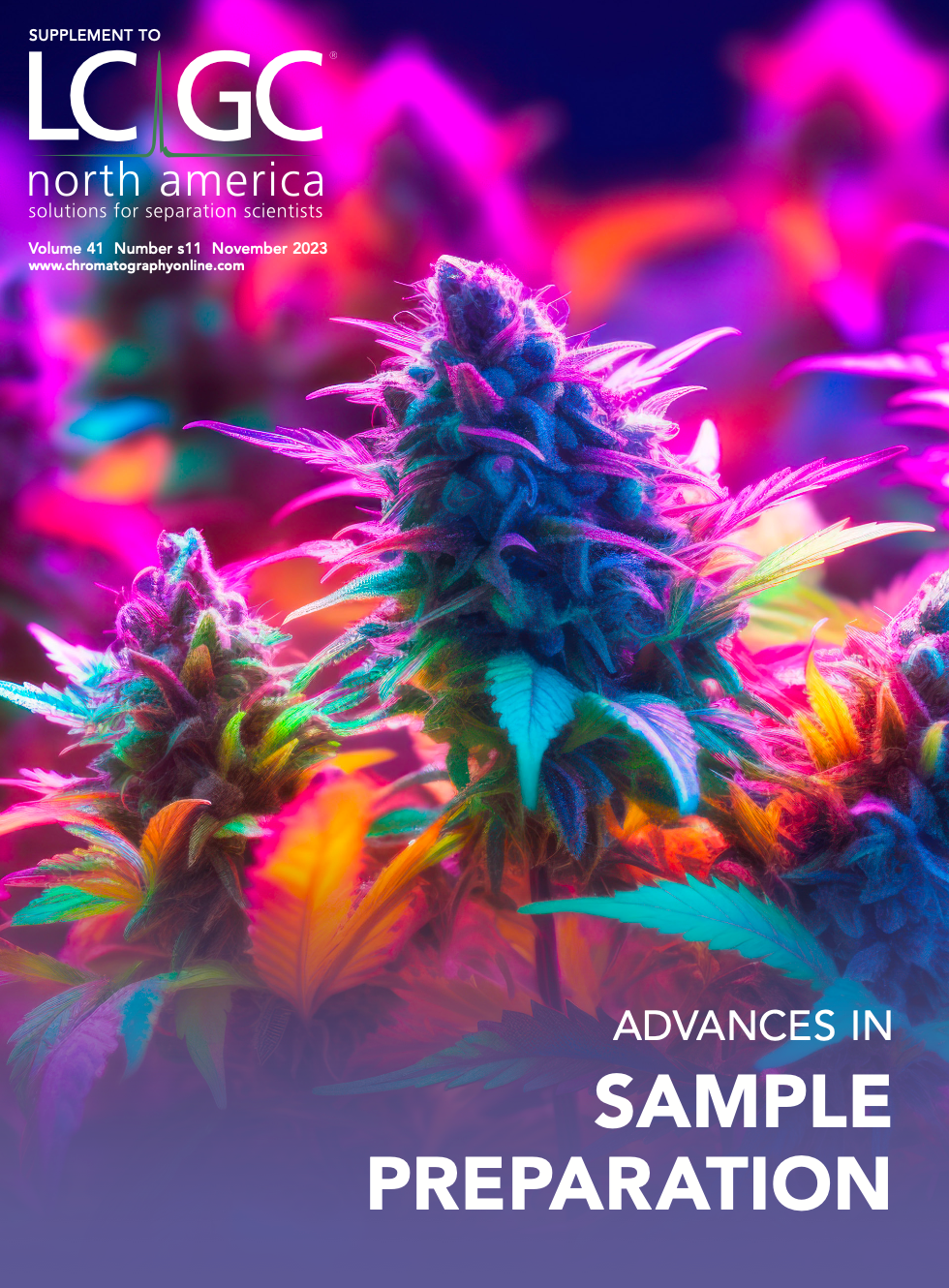
Thermodynamic Insights into Organic Solvent Extraction for Chemical Analysis of Medical Devices
April 16th 2025A new study, published by a researcher from Chemical Characterization Solutions in Minnesota, explored a new approach for sample preparation for the chemical characterization of medical devices.
Study Explores Thin-Film Extraction of Biogenic Amines via HPLC-MS/MS
March 27th 2025Scientists from Tabriz University and the University of Tabriz explored cellulose acetate-UiO-66-COOH as an affordable coating sorbent for thin film extraction of biogenic amines from cheese and alcohol-free beverages using HPLC-MS/MS.

.png&w=3840&q=75)

.png&w=3840&q=75)



.png&w=3840&q=75)



.png&w=3840&q=75)
